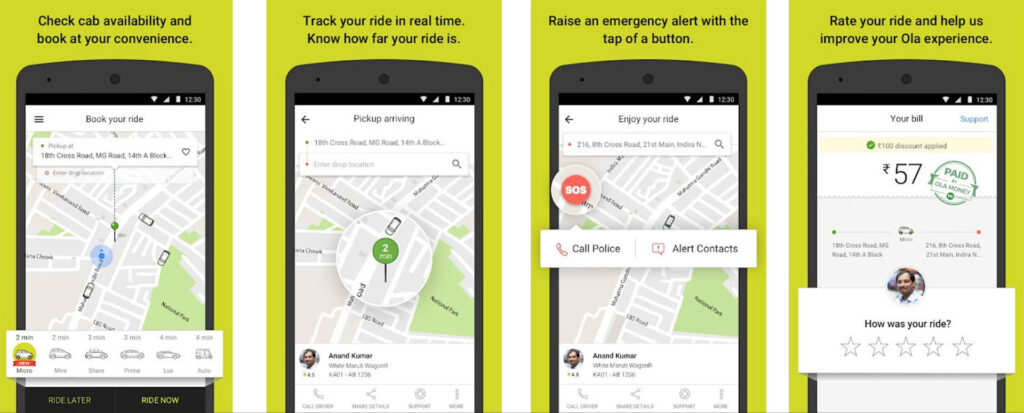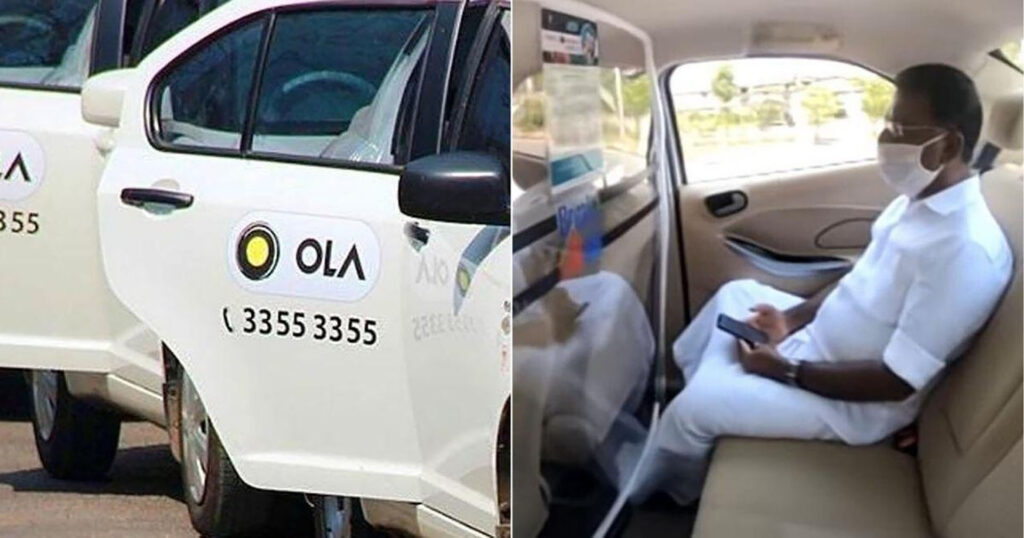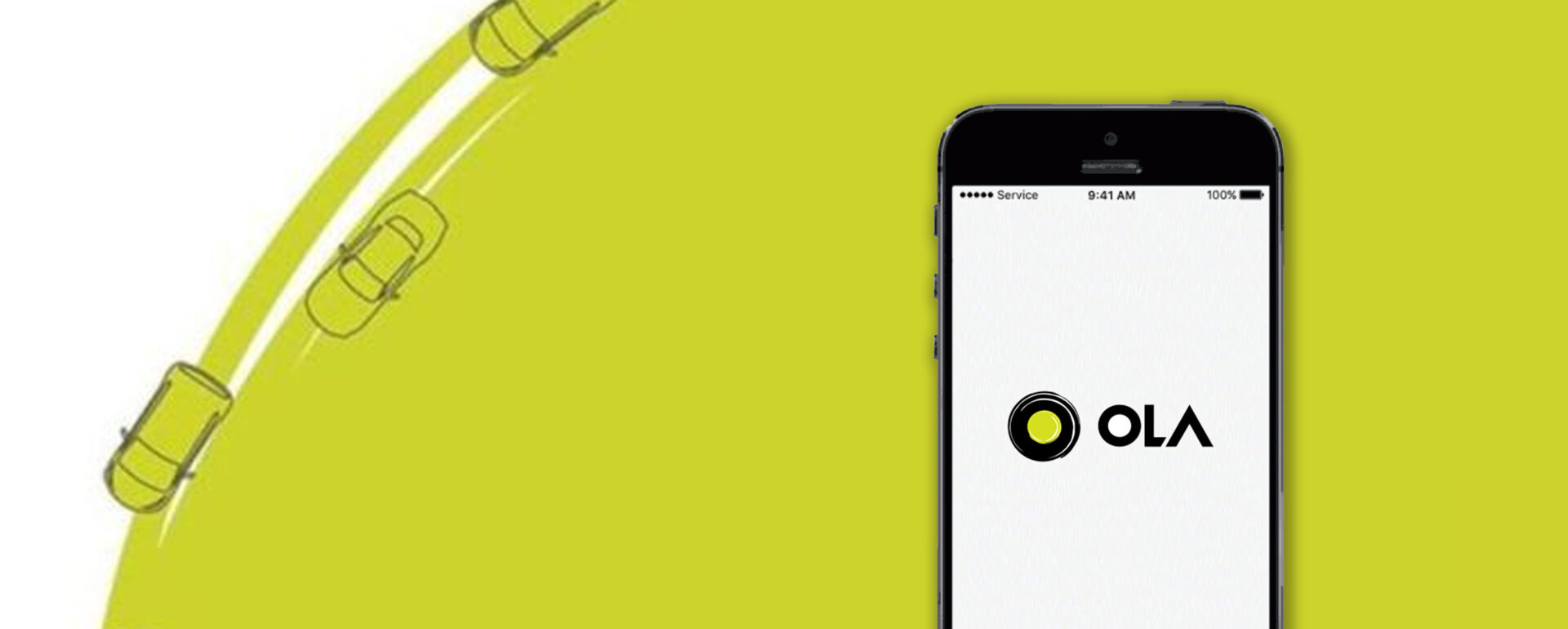If you have ever gotten up at the crack of dawn just so you can get a head start on the morning rush on the way to the office or college, you know what a hassle it is. Especially in an overcrowded country like India, where you have to constantly push your way through waves of people, all trying to access our country’s relatively limited public transportation system. This is where Ola Cabs comes in, to bridge that gap and make everyone’s lives easier.
In the Beginning, There Were Cabs
Started in December of 2010 by Bhavish Aggarwal (CEO of Ola) and Ankit Bhati (CTO of Ola) under the parent company ANI Technologies Pvt. Ltd., the brand began as the very first large-scale cab aggregator in the country.
Bhavish first started an online site named Olatrip.com that offered holiday packages and weekend trips, which he transformed into the now popular Ola Cabs. It was when once, he was left standing in the middle of the road by a very unprofessional cab driver. That driver left him stranded because Bhavish would not agree to a renegotiation of prices halfway through the ride. This brought on the realisation that the Indian cab service standards are very low or fragmented for the most part and that these kinds of situations are something that commuters have to contend with on a daily basis.
The next step after any good idea is the execution, and that is exactly what he and his business partner Ankit Bhati did. Together with the help of a talented team, they built the very first iterations of the app for Android and iOS respectively. The aim of said app was to be a feature-rich platform that not only improved the user’s experience but stayed true to the one-touch cab booking premise.
‘‘
Ola Cabs was the first large-scale cab aggregator and it took the Indian market by storm with its streamlined operation.
What Makes Ola Cabs So Special?
What makes this brand stand out as a business and especially as a product is how it closes the gap between private transportation and affordability for the average commuter. Instead of approaching the market like the traditional cab companies like the Fast Track which has an owned fleet of call taxis and cabs, Ola follows a model similar to India’s largest budget hotel chain, OYO Rooms by partnering with existing drivers and cab owners and absorbing them into its highly integrated digital platform.
This allows Ola to achieve two things: For one, the partnership-based model helps the brand to exponentially expand its reach as there is no barrier to the number of drivers who can be included under the brand umbrella. Secondly, it speeds up the booking process as everything from the driver’s contact information, payment methods, location booking and even the type of car you prefer is streamlined through a singular app that you can access through your phone.
Ola’s mission and business model centres around a hyper-local approach with one very specific goal in mind: to provide a grand total of over 1 Billion rides annually. The Indian cab aggregator has broken the market barrier and gone into the global game.
Currently, Ola is active in over 250 cities in India, Australia, New Zealand and the United Kingdom. It has saturated the Indian cab service market so much that the brand has even taken to India’s oh-so-popular auto-rickshaws and the abundant bike booking arena. To take things a step further, Ola started a bicycle sharing service called ‘Ola Pedal’ in 2017 to facilitate last-mile connectivity or short distance travel for those of us who feel like working off some stress, as the case may be.

The Ola Cabs Mobile Application and Platform
As mentioned before, the application was developed for both the Android and iOS interfaces to streamline the cab booking process for the average commuter. Now, the app itself was launched in June of 2012 and has thus far been downloaded a total of over 100 Million times on the Google Play Store alone.
Customers can access a wide range of benefits and features through the app, so without further delay let us have a look at some of the features that make this product and brand stand above the rest in the market.
Ola Daily
This is one of the three main ride types that Ola Cabs offers to its users. The Ola Daily is for the average commuter who needs to make it from point A to point B within their respective cities. The concept is fairly simple and straightforward, you log into the app, select the location you want to be dropped at, the location you are at currently and the method of payment. Then you just sit back and let the app connect you to a verified driver who will come pick you up. This is perfect for those of us who want to beat the morning traffic.
Ola Rentals
This is exactly what it sounds like, you rent a cab for how many hours or kilometres suits you and your budget. The App gives you a range of choices from a minimum of 1 hour or 10 Kilometre package up to a maximum of 24 hours or 220 Kilometre package. It’s sort of like hiring a personal limo service but with cabs.
When employing the services of a rental you can make multiple stops and go to multiple destinations using the same cab as long as it falls into the purview of the package you booked initially. This is something that is not a possibility in the daily feature, which is more of a one-and-done kind of service. Of course, if you want the ride to keep going, you can still do that, with additional charges.
Ola Outstation
Ola offers this service for those long road trips out of the city. The benefit of this feature is that it offers a very competitive price point in comparison to a lot of the outstation car rental providers like Zoomcar. With this booking feature, you can book yourself a cab out of the city almost instantly and select the type of car you want, be it a small economical car, a prime sedan or a luxury SUV.
Customers can also select if they want the cab for a one-way trip or a round-trip. Once the location is selected, the duration needs to be set, which is considered on a 24-hours basis. This means that if you opt for a two-day trip, the app will automatically set the end of the trip for 48 hours after the trip begins.
When considering the rigid pricing that many of the outstation rental services that other private cab aggregators provide, it adds up to a fairly decent package.
Ola Share Pass
Similar to buying a season ticket or pass for the bus or train, but for cabs. You buy a share pass and pay the same fare at a locked-in rate every day. There is also no peak pricing when you book a ride using Share Pass, which helps you make the most of the flat fares as per your respective city. All in all, a very economical way to commute on a regular and predictable basis.
Ola Express
This feature is a bit of a mix and match of the carpooling option and a daily option. In essence, the Ola Express feature allows customers to book cabs from point A to B, using the fastest routes with little to no deviations, hence the name express. This is particularly useful in the morning and evening six O’clock rush hours. There is a catch, however, as the rides will pick up and drop off customers based on their relative locations at pre-determined Ola pickup/drop points. These points cannot be altered and you will need to walk the rest of the way.
Ola Corporate
The Ola Corporate feature is a business travel booking option for companies who wish to track, monitor and keep better tabs on employee business trips. The rides get automatically paid through the Ola Corporate balance account that the company pre-pays for the employee.
It also makes invoicing and tracking easier. This gets rid of the hassle of collecting travel receipts and managing reimbursements, creates cost centres and helps control the budget. With Ola Corporate, employees can choose point-to-point travel or executive travel. Additionally, it also works to the benefit of night shift employees with night drops and even weekend work travels.
Ola Select
This is equivalent to the VIP section of the club. With this feature, you gain some interesting membership benefits. For one, you ride without any peak prices 24×7. Your booking is given the number one priority and connects you with the highest-rated drivers and cars in the area. You also get a host of different discounts, offers and access to events like concerts and matches.
Ola Money
Ola Cabs has taken it a step past their own name with the Ola Money scheme. Ola, in partnership with Zipcash, launched Ola Money. It can be used to pay for everything from cab fares, hotel bookings, mobile bills, DTH recharge and even electricity and gas bills. Ola Money acts as a digital prepaid wallet that you can use with anything Ola related.
Ola Safety
Ola has very high safety standards that make it a popular choice for clients. In terms of physical safety in the day-to-day scenario, all drivers under the Ola banner are verified, as are the clients who book them, once booked you have the option of sharing your location with a trusted third party to keep track of your whereabouts and there is an additional SOS button in case an emergency does arise.
In terms of the post-Covid scenario, Ola Cabs rose to the top of the pack in terms of customer popularity thanks to the myriad of safety features that they implemented across the board.
The health and safety measures during the peak pandemic months included:
- Mask usage by drivers and mandatory use by clients
- Cars sanitised and fumigated every 48 hours
- The use of safety partitions between riders and drivers
- Mandatory cleaning before and after every ride
- Temperature testing for drivers regularly
- AC off and windows down
- Self-loading of luggage to minimise contact
- Maximum 2 people in a car
- Cashless travel (i.e., OlaMoney or some other form of digital payment)

‘‘
Covid-19 and the ensuing pandemic proved a major milestone for the brand as it still managed to keep its head above water with its quick-thinking safety precautions.
A Cut Above the Rest
Clearly, Ola does not lack in terms of diversity, and it is thanks to this level of branching out and expansion that it can go toe-to-toe with some of the biggest names in the cab business, not just in India but on a global scale. Ola’s major competitors are Uber, which is at the very top of the list, followed by Zoomcar, Meru Cabs and lately Rapido. Coming in at a valuation of $ 6.5 Billion, the Ola brand is doing quite well for itself.
What makes Ola Cabs and Ola as a brand to stand out is not just the rapid level of growth but how that expansion happened. Beyond the various types of rental and booking services that the cab aggregator offers, it is ventured into the e-vehicle territory with Ola Electric which was first launched in May of 2017 as India’s first Multimodal electric vehicle project. On the other side of things, Ola launched another subsidiary project Ola Skilling, which focuses on the driver training value chain from creating training infrastructure, mobilising drivers and delivering training content and programmes to them.
Having said all that, it is quite clear why Ola Cabs and the Ola platform stand as a pack leader in the shared economy sector. They have a diverse range of products, services and packages centred around the premise of one-touch cab bookings. With everything from the booking options, safety features and the training of its drivers being so streamlined and client-oriented, it speaks to the convenience and comfort that this cab aggregator brings to the table.
For more inspiring stories check out our Inspire Section.




